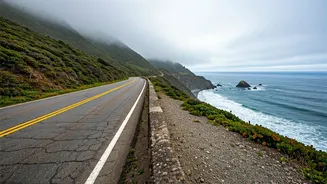Vatican City's Enclave
Vatican City, a sovereign state embraced entirely within Rome, Italy, presents a unique travel experience due to its complete lack of airports. Access
to this city-state relies entirely on ground transportation, primarily through Italy. Visitors arrive via car, bus, or the Roma Metro. This method of access adds to its secluded and exclusive feel. The absence of an airport ensures that the arrival process is intimate, enabling a smooth transition into the spiritual and historical heart of the Catholic Church. The streets are frequently bustling with pilgrims, scholars, and tourists, all arriving by the same ground routes. This arrangement fosters a sense of unity among visitors, bound by the shared experience of entering this city-state. Therefore, Vatican City is not just a destination; it's a journey into faith and history, accessed uniquely through the land and the echoes of the city around it.
Liechtenstein's Alpine Charm
Liechtenstein, a hidden gem nestled within the Alps, also lacks an airport, adding to its secluded allure. Accessing this principality mandates traversing through neighboring countries, mainly Switzerland or Austria. Travelers typically arrive via train, car, or bus, all of which navigate through breathtaking mountain landscapes. This landlocked nature ensures a tranquil entry, allowing visitors to savor the scenic beauty from the start. The absence of an airport facilitates a seamless integration with the country's surroundings, offering a deeper connection with its culture and natural beauty. The scenic drive or train ride through the Alps, leading to Liechtenstein, sets the stage for a serene and picturesque experience, preparing visitors for the serene and charming experience that awaits. Such travel routes offer an exceptional entry to this country, making it a unique and exclusive travel destination.
San Marino's Mountain Kingdom
San Marino, the historic mountain kingdom, remains another airport-free nation. This tiny republic, surrounded entirely by Italy, is accessible solely by road. The journey to San Marino is a scenic drive through the Italian countryside, revealing stunning views before arriving at the ancient capital. The journey itself provides a unique introduction to the destination, setting the scene with picturesque landscapes. This method of access offers visitors a sense of anticipation and adventure, far removed from the standardized airport travel experience. The lack of air travel strengthens San Marino's identity as a place steeped in history and tradition, emphasizing a slow, immersive travel experience. The winding roads and panoramic views that lead to this mountain kingdom offer visitors a sensory experience. This journey contrasts with the fast-paced nature of air travel and enriches the connection with the destination.
Andorra's Peak Freedom
Andorra, the mountainous principality, further emphasizes the charm of countries without airports. Nestled in the Pyrenees between France and Spain, Andorra's accessibility depends solely on overland routes. Visitors typically arrive by car or bus, traversing scenic mountain passes and picturesque valleys. The journey is part of the experience, offering stunning panoramic views of the Pyrenean landscape. This type of travel enhances a feeling of liberation and independence, reflecting the country's spirit. The experience of driving through the mountains allows for a more comprehensive engagement with the environment. This method offers a more sustainable travel approach and strengthens the unique charm of Andorra, setting it apart from destinations reliant on air travel. The drive into Andorra allows for an intimate experience with the country's rugged beauty, creating an unforgettable experience.
Monaco's Seaside Glamour
Monaco, known for its glamour by the sea, is another state without its own airport. Its location along the French Riviera dictates ground or sea-based access. Travelers typically arrive by car, train, or cruise ship, offering picturesque views of the Mediterranean coastline. The lack of air access helps maintain the city-state's exclusive atmosphere and offers a more elegant introduction to the destination. The drive along the coast, with its breathtaking views, and the arrival by train, enhance the luxury travel experience, which Monaco is renowned for. The absence of an airport underlines Monaco's identity as a prime travel destination, encouraging a relaxed, enjoyable arrival process. This travel arrangement contributes to Monaco's identity of luxury, glamour, and allure, creating an exceptional experience for every visitor.
Kiribati's Ocean Paradise
Kiribati, a nation scattered across the vast Pacific Ocean, reveals an interesting paradox. While it does possess an international airport, it's also a destination where many islands are primarily accessed by sea. This emphasizes the maritime dependency. Inter-island travel within Kiribati often requires boat travel. The primary modes of transportation across the archipelago showcase the importance of the ocean in daily life. This reliance on maritime transport showcases the country's intimate relationship with the sea and the traditions. The inter-island voyages provide a unique perspective on the nation's culture, enabling exploration of the individual islands and their different characteristics. The necessity of traveling by boat gives a rich travel experience, promoting an immersive interaction with Kiribati’s oceanic environment and the unique island communities.
No Runways, New Journeys
These seven airport-free nations highlight the diverse approaches to travel. From the mountain kingdoms to the island paradises, each offers a distinctive way of arriving, fostering a deeper bond with the culture and scenery. These countries demonstrate that the journey can be just as important as the destination, highlighting the essence of sustainable and immersive travel experiences. The absence of runways in these nations promotes a more relaxed and thoughtful pace of travel, prompting a deeper understanding of the environment and culture. The travel through these nations serves as a celebration of the beauty of the world and of slow, mindful travel. These nations demonstrate that the joy of travel lies not just in the destination, but in the experiences, memories, and observations along the way.











